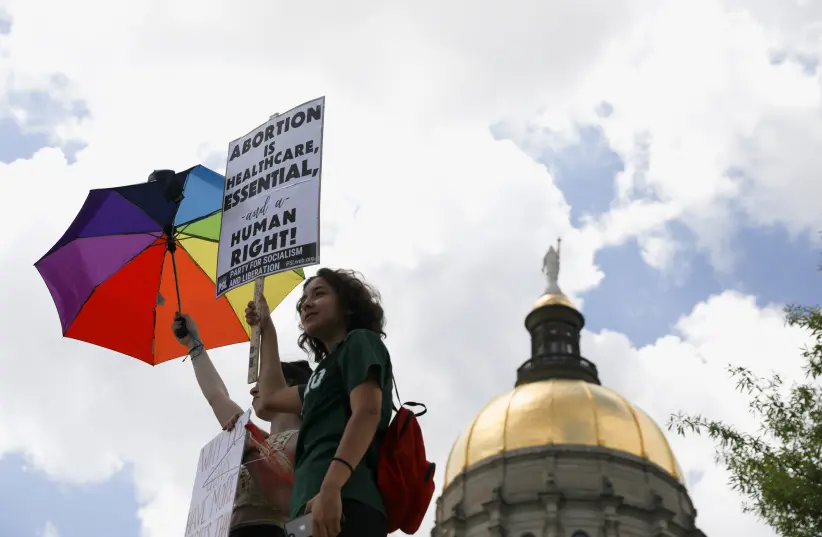After the US Supreme Court overturned Roe vs Wade, a federal court in Georgia ruled that a restrictive abortion law could take effect. Two women weigh in.

Janna Trujillo says she’s now ready to be a mother, but she wasn’t 11 years ago.
She was still in school, living in Florida, 22 years old and had recently begun what she thought was a serious relationship with a young man, but they weren’t as careful as they could have been and she became pregnant. She was conflicted, stressed and low on money, and she ended up at Planned Parenthood for an abortion.
The man would later make up stories about his education, lie about his employment and cheat on her, she says. So looking back, she has few doubts about abortion.
“I would have been a single parent and tied to that guy for the rest of my life,” Trujillo said. “I would have been on food stamps and my education would have been over.”

“I would have been a single parent and tied to that guy for the rest of my life. I would have been on food stamps and my education would have been over.”
Janna Trujillo
After training to be a hair stylist, she married and now makes a good living. She lives in Marietta with her husband, an engineer.
Her life’s trajectory depended on having the choice to end her pregnancy, an option that became illegal in many states after the US Supreme Court overturned Roe vs Wade this summer. In Georgia, a federal court ruled last week that a restrictive abortion law can take effect.
Supporters of the Georgia law argue that abortion ends a human life, that it’s a question of morality. Opponents say the decision is personal, a matter of health care and should be made by the woman.
It’s all about the money
But the issue is also one of economics.
Many women who choose abortions already have children. Many are single. Many are already financially strapped. To care for a child — or an additional child — demands money and time.
Women who have more choices about when to have a child are more likely to attend college, stay in the workforce and build careers that keep them out of poverty, said economist Mayra Pineda-Torres of Georgia Tech.
“It’s a snowball effect,” she said. “And we can expect the opposite now that Roe is overturned.”
The Georgia law forbids abortion once a doctor can detect fetal cardiac activity, which is typically about six weeks into a pregnancy.
Abortions can be performed later in cases of rape or incest, if the woman’s life is at risk, or if the fetus would not survive after birth.
The Turnaway study followed about 1,000 women who had gone to abortion clinics in different parts of the country over several years. It compared those who had abortions and those denied a procedure, often because the pregnancy was slightly more advanced than permitted by law.
Those who did not have an abortion were four times as likely to be poor five years later, according to the University of California San Francisco study.
Many of those seeking abortions are already raising children, often struggling with precarious finances, said Kwajelyn Jackson, director of the Feminist Women’s Health Center in Atlanta, a plaintiff in the case against the Georgia law. “Adding an additional child compounds the hardship for some people.”
Even before the Supreme Court’s June ruling, the right to an abortion was uneven, each state with different rules, each region in a state with different resources. Georgia’s new law will further squeeze women who are already under pressure, Jackson said.
The six-week deadline comes before many women know they are pregnant. Even those who realize in time could face daunting challenges in arranging and paying for a procedure, she said. “Ninety-five percent of the counties in the state do not have an abortion provider.”
The link between choice and economics can be traced back to the first widespread availability of contraception in the 1960s, as well as the Roe ruling in 1973, which held that abortion was a constitutional right. In the years after, women’s participation in the labor force soared, as did their wages, said Kate Bahn, chief economist at the Washington Center for Equitable Growth.
Women’s entry into the workforce “is the single factor that has maintained household income for the last 40 years,” she said.
June’s Supreme Court decision was limited to overthrowing Roe, but Justice Clarence Thomas suggested in the same ruling that the court should revisit birth control rights.
That could threaten the career of Mickey Busch, 28, of Decatur. She’s a make-up artist, working freelance in Georgia’s film industry. Jobs come and go, projects call unexpectedly, hours are unpredictable.
She uses contraceptives. Motherhood? Maybe someday, she said.
“I am only able to support myself right now, working as a freelancer and if I had a child, I don’t think I could keep freelancing,” she said. “If I got pregnant now and had to have a baby, I’d have to change my entire career path.”
An abortion at 17 allowed Gathegu Gatungo to stick with hers.
Her Kenyan family stressed education and after having the procedure, she went to college. In the years that followed, she worked as a wilderness guide and an urban farmer and traveled widely.
“When I got pregnant, I was shocked and terrified, but I was very, very certain that I didn’t want to be a mother,” she said. “I knew other teenagers who got pregnant and had their lives derailed. That wasn’t me.”
Now 48, she lives with husband and her two children in Atlanta. “As long as I am comfortable with my choice, everything else doesn’t matter.”
“As long as I am comfortable with my choice, everything else doesn’t matter.”
Gathegu Gatungo
When a woman has an unintended pregnancy that leads to the birth of a child, the odds of working full-time drop 60%, according to Diana Greene Foster, a demographer and professor at the University of California San Francisco.
Five years after being denied an abortion, a woman is more than twice as likely to need Supplemental Nutritional Assistance, known as food stamps, she said.
Even a much-desired pregnancy is a burden.
Rebecca, 38, who lives in a small town north of Atlanta and asked that her last name not be used, received government assistance through Medicaid with the delivery of her daughter last year. “Everything was paid for,” she said. “It was fantastic, because the hospital bill alone was $32,000. That was mind-boggling.”
An artist, she works sporadically. And since her partner is often away from home for his work, when she does have a job, she has to ask her mother to stay with her daughter.
“I can’t afford to pay for even a day of child care,” she said. “And if I got pregnant again, I don’t know what I’d do.”

